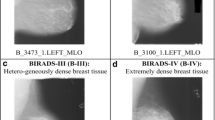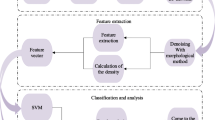Abstract
This paper presents a method for breast density classification using local quinary patterns (LQP) in mammograms. LQP operators are used to capture the texture characteristics of the fibroglandular disk region (\(FGD_{roi}\)) instead of the whole breast region as the majority of current studies have done. To maximise the local information, a multiresolution approach is employed followed by dimensionality reduction by selecting dominant patterns only. Subsequently, the Support Vector Machine classifier is used to perform the classification and a stratified ten-fold cross-validation scheme is employed to evaluate the performance of the method. The proposed method produced competitive results up to \(85.6\%\) accuracy which is comparable with the state-of-the-art in the literature. Our contributions are two fold: firstly, we show the role of the fibroglandular disk area in representing the whole breast region as an important region for more accurate density classification and secondly we show that the LQP operators can extract discriminative features comparable with the other popular techniques such as local binary patterns, textons and local ternary patterns (LTP).
Access this chapter
Tax calculation will be finalised at checkout
Purchases are for personal use only
Similar content being viewed by others
References
Cancer Research UK: Breast cancer statistics (2014). http://www.cancerresearchuk.org/health-professional/cancer-statistics/statistics-by-cancer-type/breast-cancer. Accessed 6 Jan 2017
Breast Cancer: U.S. Breast Cancer Statistics (2016). http://www.breastcancer.org/symptoms/understand_bc/statistics. Accessed 6 Jan 2017
Oliver, A., Freixenet, J., Martí, R., Pont, J., Perez, E., Denton, E.R.E., Zwiggelaar, R.: A novel breast tissue density classification methodology. IEEE Trans. Inf Technol. Biomed. 12(1), 55–65 (2008)
Bovis, K., Singh, S.: Classification of mammographic breast density using a combined classifier paradigm. In: 4th International Workshop on Digital Mammography, pp. 177–180 (2002)
Oliver, A., Tortajada, M., Lladó, X., Freixenet, J., Ganau, S., Tortajada, L., Vilagran, M., Sentś, M., Martí, R.: Breast density analysis using an automatic density segmentation algorithm. J. Digit. Imaging 28(5), 604–612 (2015)
Muštra, M., Grgić, M., Delać, K.: A Novel breast tissue density classification methodology. Breast density classification using multiple feature selection. Automatika 53(4), 362–372 (2012)
Parthaláin, N.M., Jensen, R., Shen, Q., Zwiggelaar, R.: Fuzzy-rough approaches for mammographic risk analysis. Intell. Data Anal. 14(2), 225–244 (2010)
Chen, Z., Denton, E., Zwiggelaar, R.: Local feature based mamographic tissue pattern modelling and breast density classification. In: The 4th International Conference on Biomedical Engineering and Informatics, pp. 351–355 (2011)
Bosch, A., Munoz, X., Oliver, A., Martí, J.: Modeling and classifying breast tissue density in mammograms. In: Computer Vision and Pattern Recognition (CVPR 2006), pp. 1552–1558 (2006)
Chen, Z., Oliver, A., Denton, E., Zwiggelaar, R.: Automated mammographic risk classification based on breast density estimation. In: Sanches, J.M., Micó, L., Cardoso, J.S. (eds.) IbPRIA 2013. LNCS, vol. 7887, pp. 237–244. Springer, Heidelberg (2013). doi:10.1007/978-3-642-38628-2_28
Byng, J.W., Boyd, N.F., Fishell, E., Jong, R.A., Yaffe, M.J.: Automated analysis of mammographic densities. Phys. Med. Biol. 41(5), 909–923 (1996)
He, W., Denton, E., Stafford, K., Zwiggelaar, R.: Mammographic image segmentation and risk classification based on mammographic parenchymal patterns and geometric moments. Biomed. Sig. Process. Control 6(3), 321–329 (2011)
Petroudi, S., Kadir, T., Brady, M.: Automatic classification of mammographic parenchymal patterns: a statistical approach. In: Proceedings IEEE Conference Engineering in Medicine Biology Society, vol. 1, pp. 798–801 (2003)
Ojala, T., Pietikainen, M., Maenpaa, T.: Multiresolution gray-scale and rotation invariant texture classification with local binary patterns. IEEE Trans. Pattern Anal. Mach. Intell. 24(7), 971–987 (2002)
Nanni, L., Luminia, A., Brahnam, S.: Local binary patterns variants as texture descriptors for medical image analysis. Artif. Intell. Med. 49(2), 117–125 (2010)
Tan, X., Triggs, B.: Enhanced local texture feature sets for face recognition under difficult lighting conditions. In: Analysis and Modelling of Faces and Gestures, pp. 168–182 (2007)
Suckling, J., et al.: The mammographic image analysis society digital mammogram database. In: Proceedings of Exerpta Medica. International Congress Series, pp. 375–378 (1994)
Rampun, A., Morrow, P.J., Scotney, B.W., Winder, R.J.: Fully automated breast boundary and pectoral muscle segmentation in mammograms. Artif. Intell. Med. (2017, under review)
Gio, Y., Zhao, G., Pietikäinen, M.: Discriminative features for feature description. Pattern Recogn. 45, 3834–3843 (2012)
Rampun, A., Winder, R.J., Morrow, P.J., Scotney, B.W.: Breast density classification in mammograms using local ternary patterns. In: International Conference on Image Analysis and Recognition (2017)
Acknowledgments
This research was undertaken as part of the Decision Support and Information Management System for Breast Cancer (DESIREE) project. The project has received funding from the European Union’s Horizon 2020 research and innovation programme under grant agreement No. 690238.
Author information
Authors and Affiliations
Corresponding author
Editor information
Editors and Affiliations
Rights and permissions
Copyright information
© 2017 Springer International Publishing AG
About this paper
Cite this paper
Rampun, A., Morrow, P., Scotney, B., Winder, J. (2017). Breast Density Classification Using Multiresolution Local Quinary Patterns in Mammograms. In: Valdés Hernández, M., González-Castro, V. (eds) Medical Image Understanding and Analysis. MIUA 2017. Communications in Computer and Information Science, vol 723. Springer, Cham. https://doi.org/10.1007/978-3-319-60964-5_32
Download citation
DOI: https://doi.org/10.1007/978-3-319-60964-5_32
Published:
Publisher Name: Springer, Cham
Print ISBN: 978-3-319-60963-8
Online ISBN: 978-3-319-60964-5
eBook Packages: Computer ScienceComputer Science (R0)




